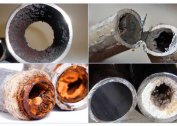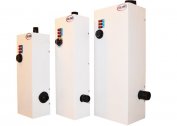Insulation of the ceiling - the procedure is no less important than the insulation of other surfaces. It is through the ceiling that almost 1/5 of the heat from the rooms leaves. Also, condensation often forms on the ceiling, increasing humidity inside the house (apartment), promoting the propagation of fungi, negatively affecting the health of the owners and the decoration of the ceiling and walls. All this presents certain requirements for the thermal insulation of the ceiling and encourages compliance with certain rules during the work.
Warming Rules
 For the most effective thermal insulation of the ceiling, moisture should not accumulate in the heater. Therefore, before laying the thermal insulation layer, it is necessary to make high-quality vapor and waterproofing. For example, to remove moisture that has accumulated in the ceiling of the ceiling and prevent its further penetration, the surface of the ceiling can be treated with special waterproofing compounds. Apply them even on a damp surface and in cracked places (if the width of the cracks does not exceed 3 mm).
For the most effective thermal insulation of the ceiling, moisture should not accumulate in the heater. Therefore, before laying the thermal insulation layer, it is necessary to make high-quality vapor and waterproofing. For example, to remove moisture that has accumulated in the ceiling of the ceiling and prevent its further penetration, the surface of the ceiling can be treated with special waterproofing compounds. Apply them even on a damp surface and in cracked places (if the width of the cracks does not exceed 3 mm).
When laying insulating material, do not play it safe and put it in too thick a layer. It is important to choose the optimum thickness so that the heat insulator does not interfere with the evaporation of moisture from the room.
The most high-quality and environmentally friendly materials should be used as a heat-insulating material.
Insulation of the ceiling in the apartment
In the apartment, all work on heat, hydro and vapor barrier is carried out from the inside, so I want these materials not only to be of high quality, but also to look aesthetically and beautifully. Of course, you can hide the entire structure with decorative finishing materials. However, each subsequent layer conceals additional centimeters, making the ceiling lower and reducing the volume of the room. The best option is those materials that simultaneously serve as insulators and original finishes.
Warm plaster
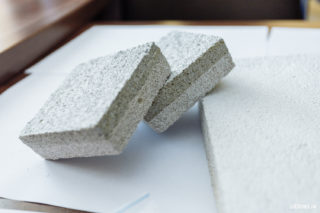 One of the advantages of insulation is that it does not need to install a frame. This is a dry mixture of porous fillers and plasticizing agents that bind to gypsum. Expanded clay, expanded polystyrene, expanded mineral heat insulators (vermiculite, perlite), etc. are used as fillers. Such plaster is applied in a single layer. Moreover, the ceiling surface does not require prior alignment and laying of the reinforcing mesh. With proper application, no final finishing is required.
One of the advantages of insulation is that it does not need to install a frame. This is a dry mixture of porous fillers and plasticizing agents that bind to gypsum. Expanded clay, expanded polystyrene, expanded mineral heat insulators (vermiculite, perlite), etc. are used as fillers. Such plaster is applied in a single layer. Moreover, the ceiling surface does not require prior alignment and laying of the reinforcing mesh. With proper application, no final finishing is required.
Bung
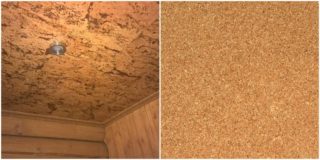 Another type of insulation that does not need finishing is cork agglomerate. This unique material is not afraid of moisture. At the same time, it is very lightweight itself, and it can be mounted both on the crate and with glue.
Another type of insulation that does not need finishing is cork agglomerate. This unique material is not afraid of moisture. At the same time, it is very lightweight itself, and it can be mounted both on the crate and with glue.
Among the various advantages of cork is a wide selection of its textures and colors, as well as the fact that it can be painted in any color you like. In addition, such a coating will easily hide small irregularities and disadvantages of the ceiling. And yet, polymers are not used in the manufacture of cork agglomerate, therefore it is environmentally friendly and has hypoallergenic properties. At the same time, the presence of a cement base is a prerequisite for gluing the cork finish. That is, if before that there was a different finish on the ceiling, then it will be necessary to remove and clean the ceiling to the very cement base.
Ecopanels
One of modern heat-insulating materials with a volume surface. Its use will not only help to qualitatively and reliably insulate the ceiling, but also create an original and beautiful design of the room.Such panels are made of natural materials (cellulose, bamboo, reed, etc.) with the addition of organic resins. They are attached to glue, which makes them easy to use and very beneficial in all respects.
Thermal insulation of ceilings in houses
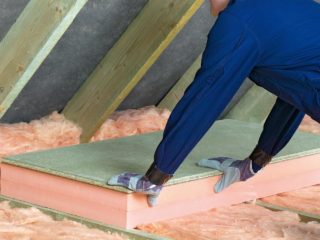 In the house, the ceiling is insulated in several cases: in the presence of a basement or basement and with the equipment of the attic and attic floor. In the first case, it is more advisable to install heat-insulating materials from the side of the first floor. However, when the features of the flooring do not allow the use of this option, the insulation is made from the inside of the basement.
In the house, the ceiling is insulated in several cases: in the presence of a basement or basement and with the equipment of the attic and attic floor. In the first case, it is more advisable to install heat-insulating materials from the side of the first floor. However, when the features of the flooring do not allow the use of this option, the insulation is made from the inside of the basement.
Insulators in this case can serve as polystyrene, mineral wool, expanded polystyrene, etc. At the same time, it is better to choose plate, rather than rolled materials, since working with plates is much more convenient.
On top of the insulation, it will be necessary to stick a layer of plastic film or foil, which will serve as a vapor barrier, and then finishing materials. One of the options for basement insulation is the use of liquid polyurethane foam. But using it yourself will not work, as special equipment is needed.
As for the ceiling in the house itself (on the top floor), it is insulated from the attic. Expanded clay, vermiculite, granular polystyrene foam and other loose heaters are perfect for this. Thermal insulation materials are poured onto the roofing material layer between the wooden logs treated with antiseptic agents. If the insulation used is a combustible substance, then it must be poured with a cement mixture.

